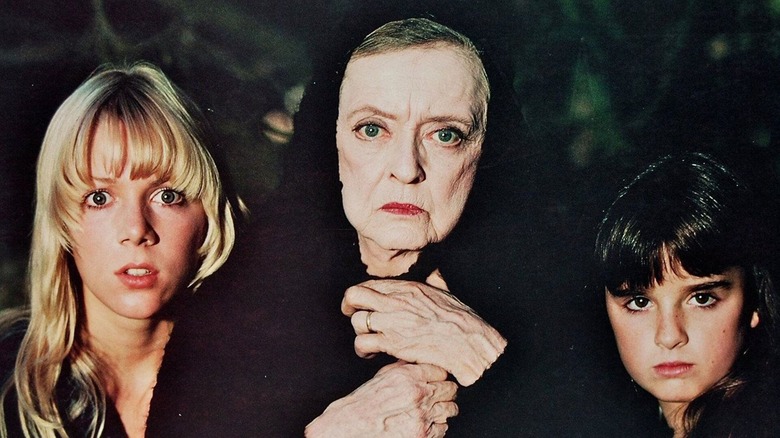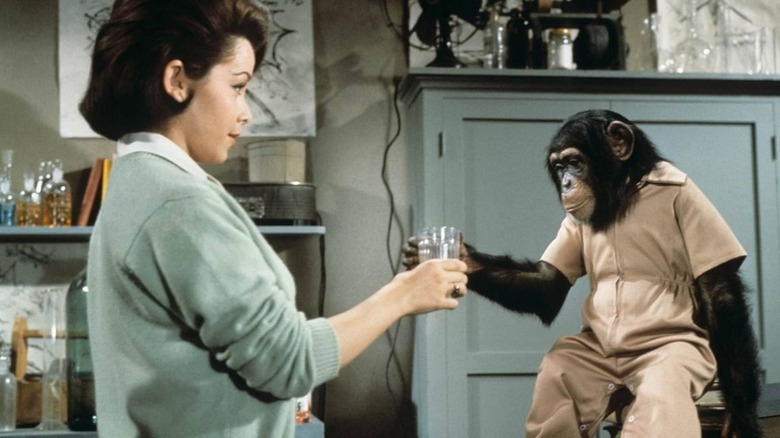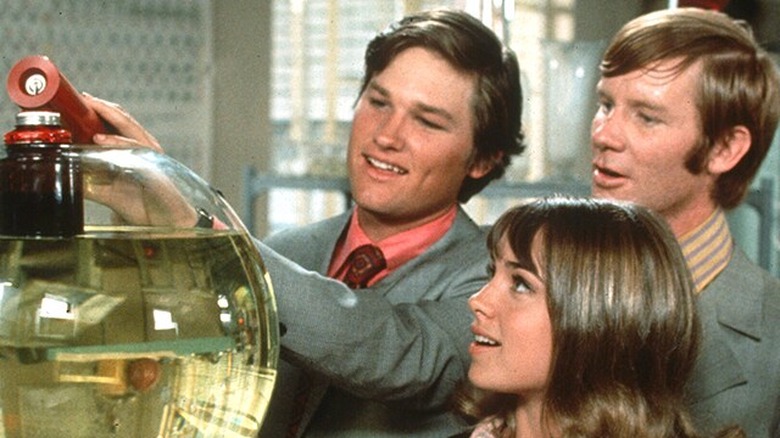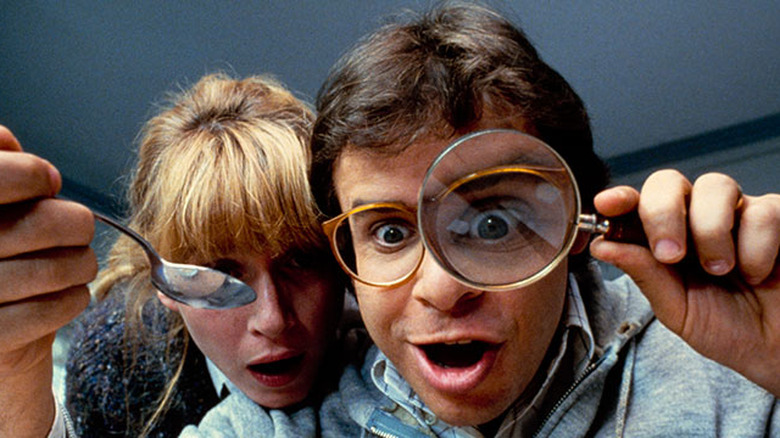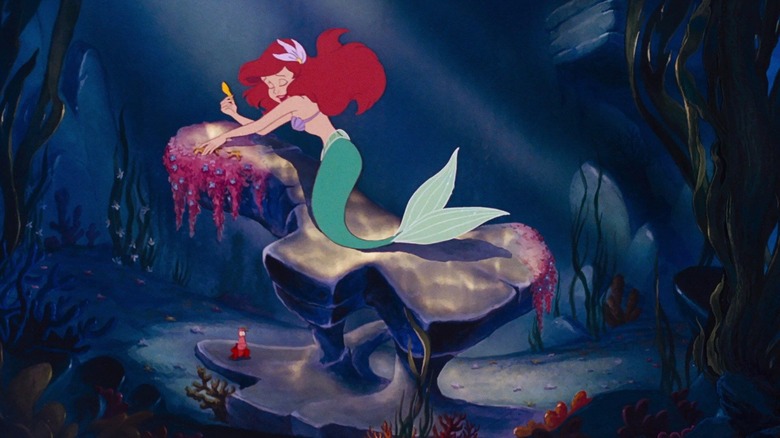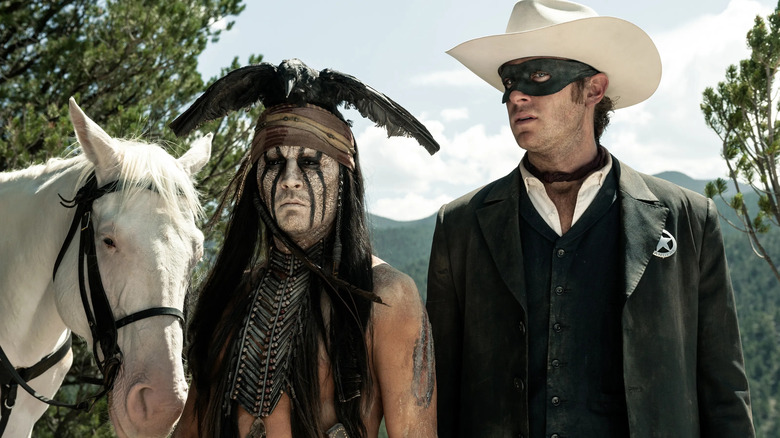Disney's Most Interesting And Innovative Films Came When The Company Was Suffering
Long ago, the 1950s ended and Disney never really got over it.
With the right kind of eyes, a casual viewer can look at the early days of Walt Disney Studios as their heyday. Walt himself was still alive and using his aggressive business acumen to produce visually innovative and award-winning animated shorts that were helping put the studio on the map. Without the Silly Symphonies, animation would not be the same. Warner Bros. outstripped Disney's fare with their cheekier, funnier shorts in the 1940s and 1950s, but the folks at Warner's Termite Terrace were very open about the fact that Merrie Melodies and Looney Tunes were ripping off Disney's Silly Symphonies name. Disney Animation broke onto the scene in 1937 with the release of "Snow White and the Seven Dwarfs," still celebrated as one of the best of all animated films to this day.
The reason early Disney was so exciting was because it was experimenting. There wasn't yet an established brand for the company and they were willing to try new things. They didn't have a "house aesthetic" yet because they were still developing it.
For the next 20 years, Disney churned out hit after hit. Not only was their animated fare consistently impressive, but they began stretching into live-action adventure films as well. The 1950s saw the release of films like "Peter Pan," "Cinderella," "Sleeping Beauty," and "Lady and the Tramp," but also hits like "20,000 Leagues Under the Sea," animal films like "Perri" and "Old Yeller," and "boys adventure novel" films like "Davy Crockett," "Westward Ho Wagons!," and, come 1960, "Swiss Family Robinson."
In the early 1960s, the hits rolled on briefly but came to a sudden halt in 1966 when Walt died.
Thereafter, a pattern emerged. When rich, stay the course. When impoverished, innovate.
The ups and downs of Disney
One can trace a palpable and definite sine wave of Disney's power as a company. They tend to be on the rise for a prolonged period before their style will fall out of fashion. They will then struggle to innovate for 10 to 15 years before they get a toehold again, and then ride their new success across another period. They will fall, innovate, find a toehold, and rise again. Sunrise, sunset.
One can see Disney struggling to invent an ethos throughout the late 1960s, and they made a lot of weird movies at the time, both good and bad. It's worth remembering that Disney, through their "adventure novel" movies, fantasy worlds built in Disneyland (which opened on July 17, 1955), and square-jawed depictions of frontier Americana, pretty much established the common perception of what America is "supposed to look like."
It was through Disney media that an operational political ethos began to form and the idylls of modern Conservatism took root. It's fascinating to ponder that the fabric of modern America can be dissected through Disney's mainstream children's media, but here we are.
When norms were challenged in the 1960s, Disney attempted to become "hip," often to embarrassing results. A lot of their more playful fare continued — "The Parent Trap," "One Hundred and One Dalmatians," "Kidnapped!," "Mary Poppins," and "Pollyanna" were notable early-'60s hits — but they also released risable youth-geared films like "The Monkey's Uncle" and attempts at genre deconstruction like "Blackbeard's Ghost," "The Gnome-Mobile," and even "The Love Bug."
In a time when a lot of media was getting more hip and adult — "Bonnie and Clyde" came out in 1967 — Disney was torn between retaining its 1950s squareness and attempting to capture a neo-teen audience.
The weird 1970s
Here's the thing about those misguided attempts at capturing a youth audience: they're fascinating to watch.
As Hollywood began gathering around "Easy Rider" and "Midnight Cowboy" and "Five Easy Pieces" in 1969 and 1970, Disney was largely cut adrift from the mainstream conversation. They were trying to delve into new territory and invent new notions. It was in the late '60s and early '70s that Disney tried their hand at a series of Medfield College comedies with "The Computer Wore Tennis Shoes," and "Now You See Him, Now You Don't." Their fantasy films got a little weirder, and they upped their comedy quotient. The 1970s saw "The Million Dollar Duck," "Snowball Express," "The Apple Dumpling Gang," and "Freaky Friday." It's odd to think, in 2023, that Disney was once the primary producer of high-profile, high-concept, live-action comedy films. They needed to innovate.
Animal films continued to be of interest to the studio, although few fondly remember films like "The Biscuit Eater," "Napoleon and Samantha," and "The Bears and I." It seems that when Disney tried their old formulas, no one paid attention.
Meanwhile, Disney's animated output began to suffer. "The Aristocats" wasn't drawing huge numbers, and "Robin Hood" was a clearly low-budget animal-forward rendition of the classic tale that, to today's eyes, feels like a stoner movie. The animation department, after severe budget cuts, relied on copying their animation cels using a cheaper process called xerography, making their animated films look shaggy and cheap. Even the popular "The Many Adventures of Winnie-the-Pooh" felt small. Xerography provided animation an undeniably interesting look, but it was a far cry from "Snow White."
The early 1980s were grimmer still for Disney. But, given what they were forced to try, great for audiences.
The weird 1980s
The 1980s were a fascinating, fascinating time for Disney, probably because their films started to bomb out pretty hard. One might recall that "Star Wars" came out in 1977, and Disney's old hits about princesses and musical animals now seemed old-fashioned and trite. They tried their hand at a sci-fi effects blockbuster in 1979 with "The Black Hole," which is visually astonishing ... and also weird. They kept on pushing pulp, comic book sci-fi with movies like "Condorman," "TRON," and "Dragonslayer." The studio began to affect a darker tone, trying to update their bright, chipper associations with the 1950s into the nihilism of the '80s. The beatific "The Fox and the Hound" crashed hard. It was time to change things up.
The new stylistic clashes didn't necessarily make the studio money, but golly it was great to see Disney innovating. The 1980s became a low point for the studio financially, but a high point creatively. Disney began teaming up with other studios to make more mature fantasy movies, often contributing to children's nightmares more than their dreams. The entire "house aesthetic" was finally dropped, and their new philosophy seemed to be to become disassociated with children's movies.
Hence, "Something Wicked This Way Comes," a truly terrifying horror movie for kids based on a work by Ray Bradbury. Hence "The Watcher in the Woods." Hence "Return to Oz," "Never Cry Wolf," "Flight of the Navigator," and the adult-geared "Trenchcoat" and "Tex." They also released "Who Framed Roger Rabbit?" under their Touchstone label.
Their hail-mary pass to save the animation studio was "The Black Cauldron," which lost the studio tons of money. They had to go small-budget-high-concept. By 1989, Rock Moranis was shrinking his kids, Sherlock Holmes was a mouse, and Oliver Twist hung out with Billy Joel.
The Disney Renaissance ruined everything
CEO Roy O. Disney died in the 1970s. Under his tenure, Disney parks became larger. There were no Disneys left in charge in the 1980s.
Pause for a moment to think of what Disney, as a studio, might have looked like were it not for "The Little Mermaid." Seeing as where they were in the late 1980s, it might have been a more varied, interesting place. Disney was, one could see, slowly — after decades of trying — to shed their "kiddie film" shell and break into adult dramas, into horror movies, into hard-edged fantasy. Disney was already releasing more adult fare through Touchstone and through Hollywood Pictures, and it seemed that Disney itself might be pointed in the same direction. Imagine a world where Disney actually shuttered their animation studio in 1988 (which was an actual discussion being had) and became just as widespread in their output as Warner Bros. or Universal or Paramount.
"The Little Mermaid" was released in 1989, and it was a massive success. It saved the animation studio and ushered in what is often called the Disney Renaissance. It was followed by multiple massive hits throughout the '90s that the studio is still buoying itself with; they have remade "The Little Mermaid" along with "Aladdin," "Beauty and the Beast," and many others. One can likely point directly to CEO Michael Eisner, who took the position in 1984 and led the company to its rebirth. It was during this time that Disney began to scoop up other companies in a desperate bid to be relevant. Eisner stayed in power until 2004.
Disney today
In recent years, one can see another slump in Disney's output, although their solution on the latest cycle of its sine wave was less to do with innovation and more to do with acquisition.
In the 2000s, Disney's animated fare began to suffer again — DreamWorks provided legit competition — and the studio began to flounder. "Treasure Planet" lost a huge amount of money and no one cared about "Dinosaur," or "Home on the Range." Disney announced they would only make CGI animated comedies from then on, leading to more bombs like "Chicken Little," and "Meet the Robinsons." They had a hit with "Pirates of the Caribbean," but their attempts to recreate that "boys' adventure" vibe tanked miserably with "The Lone Ranger" and "John Carter."
Rather than innovate during a fallow time, Disney's more recent solution was to purchase things that were already successful. They bought out Marvel Comics. They bought out "Star Wars." They coasted on nostalgic goodwill built by others. They remade their own movies.
Disney may be hot s*** right now because of a decade of Marvel and Star Wars and remake success, but one can see the studio's utter lack of creativity at play. There's no necessity, so there's no invention. It's just exploiting things that are already known. Disney has long been in a phase where it's milking itself dry. The snake has fully digested its own tail and is now feeding on the excrement left behind.
Of course, with the failure of films like "Indiana Jones and the Dial of Destiny" and the general slide in popularity of the Marvel Cinematic Universe, Disney may be entering a "dark" period again. This may be bad for the studio, but the audience wins in the end. I can't wait to see what strange creative decisions they make in the very near future.
